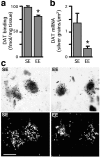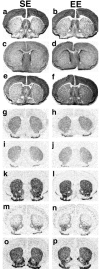Enriched environment confers resistance to 1-methyl-4-phenyl-1,2,3,6-tetrahydropyridine and cocaine: involvement of dopamine transporter and trophic factors
- PMID: 14657156
- PMCID: PMC6741042
- DOI: 10.1523/JNEUROSCI.23-35-10999.2003
Enriched environment confers resistance to 1-methyl-4-phenyl-1,2,3,6-tetrahydropyridine and cocaine: involvement of dopamine transporter and trophic factors
Abstract
We investigated, in mice, the influence of life experience on the vulnerability to 1-methyl-4-phenyl-1,2,3,6-tetrahydropyridine (MPTP), a major neurotoxin that induces a Parkinson's disease-like syndrome in humans, and to cocaine, a potent psychostimulant that promotes drug addiction. Our findings show that adult C57BL/6 mice raised in an enriched environment (EE) for only 2 months are significantly more resistant to both drugs compared with mice raised in a standard environment (SE). Indeed, EE mice showed decreased locomotor activity in response to cocaine (10 and 20 mg/kg) as well as a different pattern of c-fos expression in the striatum compared with SE mice. After MPTP treatment, SE mice showed a 75% loss of dopamine neurons, whereas EE mice showed only a 40% loss. The dopamine transporter plays a key role in mediating the effects of both drugs. We thus investigated the regulation of its expression. EE mice showed less dopamine transporter binding in the striatum and less dopamine transporter mRNA per dopamine neuron at the cellular level as demonstrated by in situ hybridization. In addition, enriched environment promoted an increase in the expression of brain-derived neurotrophic factor in the striatum. These data provide a direct demonstration of the beneficial consequences that a positive environment has in preventing neurodegeneration and in decreasing responsiveness to cocaine. Furthermore, they suggest that the probability of developing neurological disorders such as Parkinson's disease or vulnerability to psychostimulants may be related to life experience.
Figures






References
-
- Badiani A, Browman KE, Robinson TE ( 1995) Influence of novel versus home environments on sensitization to the psychomotor stimulant effects of cocaine and amphetamine. Brain Res 674: 291-298. - PubMed
-
- Bezard E, Dovero S, Bioulac B, Gross C ( 1997) Effect of different schedules of MPTP administration on dopaminergic neurodegeneration in mice. Exp Neurol 148: 288-292. - PubMed
-
- Bezard E, Gross CE, Fournier MC, Dovero S, Bloch B, Jaber M ( 1999) Absence of MPTP-induced neuronal death in mice lacking the dopamine transporter. Exp Neurol 155: 268-273. - PubMed
-
- Bezard E, Ravenscroft P, Gross CE, Crossman AR, Brotchie JM ( 2001a) Upregulation of striatal preproenkephalin gene expression occurs before the appearance of parkinsonian signs in 1-methyl-4-phenyl-1,2,3,6-tetrahydropyridine monkeys. Neurobiol Dis 8: 343-350. - PubMed
-
- Bezard E, Boraud T, Chalon S, Brotchie JM, Guilloteau D, Gross CE ( 2001b) Pallidal border cells: an anatomical and electrophysiological study in the MPTP-treated monkey. Neuroscience 103: 119-125. - PubMed
Publication types
MeSH terms
Substances
Grants and funding
LinkOut - more resources
Full Text Sources
